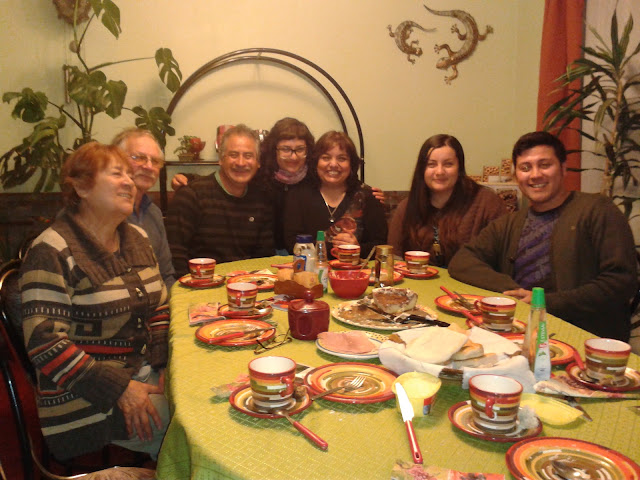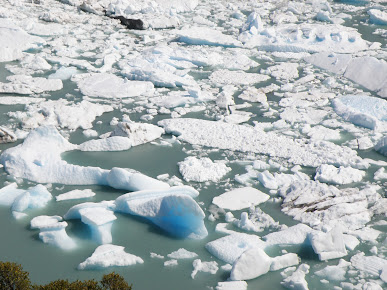Have
couch, will travel
By
Aditi De

Fabio and Giselle in Sao Paulo, Brazil 
Ingeborg and her family in Valparaiso, Chile 
Carla, who took me to the End of the World. Tierra del Fuego. Ushuaia. Argentina. 
Fabio and Giselle at a Cha Garden outside Sao Paulo that we visited on my last day in South America. Brazil. 
Milagros and her daughter Agustina. Mendoza. Argentina. %20with%20her%20parents%20and%20sister.jpg)
The wonderful Biancos, my first ever Couchsurfing hosts. Buenos Aires. Argentina. 
The Holz Bustamante family made me feel completely at home. Valparaiso. Chile.
''Nobody from our family has ever been to South America. You should go. But where will you stay?’ asks
Ma anxiously in early 2013. ‘Did you say seven countries in 99 days? Have you
found good hotels? Do you have friends in that continent?’
The answer is clear:
no, many times over. Ma knows I wander to recharge my creative batteries as a
writer. Not as a luxury vagabond or a tourist, but as a traveller seeking the human
touch. Faces and stories always win over checklists and monuments. Once 22
flights and multiple visas are covered, my shoestring budget will not stretch
to hotels or Air B&Bs. Yet, the call of the unknown must be answered.
Over 28 stops, a mix of
two options seems workable. One is Youth Hostelling International, embracing generations,
a positive choice while backpacking through Ireland and Scotland in 2001. The
other? Founded in San Francisco in 2004, Couchsurfing – a cost-free online
hospitality exchange – has a current global membership of over 14 million. An
unimaginable cultural interchange blooms. So do friendships beyond imagining.
Creating a Couchsurfing
profile proves simple: Single,
footloose, nearly 60, addicted to reading and writing, art and theatre, music
and dance, textiles and crafts.
How will folks in Buenos
Aires, my first stop, respond? Over 20 Argentinian Couchsurfers, between 21 and
65, offer their homes. After scanning promising hosts, I settle on Magali.
Barely 32, a corporate employee, she lives with her parents. Shall I cook them
an Indian meal, topped off with Torta Tres Leches, a luscious South American cake
I have mastered in Bengaluru? Yes.
Warming to Couchsurfing,
in May 2013, I host 18-year-old Rita from Taiwan, on her first trip to India. Boycotting
ageism, we bond as storytellers and listeners, foodies to boot. We try the
Bengaluru metro. We lunch with an artist friend. We take in a children’s play,
partly in gibberish, at the perfect Ranga Shankara theatre. Rita’s impressions:
‘Everyone told me Bengaluru was a boring IT city. But I loved your life, your beautiful
home, cooking with you….’ We remain in touch.
As for me, four years
on, my Buenos Aires lingers vividly. At Pistarini airport at 9.40 pm in October
2013, doubts assail me. Will I recognize my host from her Couchsurfing profile?
How does one operate an Argentinian ATM? Dare I approach strangers for help
with my sprinkling of Spanish? Magali’s dazzling smile dispels my doubts.
The next morning, she hands
me her bus pass. Papa Osvaldo changes my dollars into Argentinian pesos.
Impressions of their capital still tango by. Of a huge Peronista demonstration for
Loyalty Day in the historic Plaza de Mayo, reminiscent of a rebellious Kolkata.
Of voices raised for the homeless, for civil rights, for justice for the maimed
veterans of the 1982 Malvinas (a.k.a. Falkland islands) war.
The capital shows another
facet within the swank 11,000 sq. m. Gallerias Pacifico on Avenida Cordoba.
Housed in a building dating back to 1889, we admire the fabulous frescoed
ceilings. Magali and her friends point out stylish Argentinian brands,
including Adriani Constantini, Maria Cher and El Boyero. Chancing upon ‘Indian
Style,’ overflowing with oriental scarves and beaded bags, we collapse in
laughter in the passageway.
Suddenly, Julietta
breaks in, ‘A film crew was shooting a documentary here in 1987. They found a grim
sight in the basement. Fingernails had etched cries for help on the walls of
this former torture chamber. For the military dictatorship that governed Argentina
from 1976 to 1983 was merciless. Over 30,000 people ‘disappeared.’” This slice-of-life story shakes us into
silence.
In my transit home away
from India, Argentinians prove to be as family-centric as Indians. Magali gives
me her pretty bedroom. Osvaldo sets up a traditional Sunday asado of barbequed meats for the
extended family. On Mother’s Day, we toast Mama Analia with champagne over a
lavish infinity buffet at Gourmet Porteno in upmarket Puerto Madera, as the Rio
de la Plata flows by.
Six days later, as I
repack for the magnificent Iguazu waterfalls, we guffaw over shared experiences.
How I tried to teach Magali and Analia basic shavasana, disrupted when their shaggy dog Brianna joined in. How
easily I took to the traditional herbal yerba
mate drink at Analia’s insistence. At 2 a.m., they shower me with gifts,
including a lace-edged handmade poster that says, ‘Follow Your Dreams.’
My Couchsurfing saga continues
at Mendoza in north-central Argentina. Milagros, a single mother and a chef,
hosts me. She wangles a free conducted trip to the Bodega Zuccardi in the Maipu
wine region where, amidst giant vats, wooden kegs and bottles of prized
vintage, their staff offer glimpses of generations-old family secrets. Over olive
oil ice-cream, we agree that their Santa Julia Malbec is as glorious as the
world’s best red wines.
Milagros’s daughter
Agustina, 16, is immersed in J. Krishnamurthi’s philosophy (in Spanish
translation). They pepper me with questions: Are all Indians spiritual? What
does the bindi signify? Will I lose
my passport if I eat beef in Argentina? Do I wear a saree 24/7 in India?
Night-long conversations disperse their misconceptions as we weave through
love, loss and all life in between.
At Valparaiso, the picturesque
Chilean port straddling 44 hills, I make a quixotic choice. For Ingeborg, a
young textile designer, has a lyrical line from our favourite poet Pablo Neruda
tattooed across her forearm. Her father Hans, a marine engineer, has visited
Mumbai. Her mother Gladys repairs computers over the internet. But the family’s
star is undoubtedly Hans’s mother, Agnes. Still sparkling at 82, she jokes
about all her boyfriends before she met grandpa Hector, her constant sparring
partner. She gamely troops up and down ancient stone steps to share a scenic viewing
point.
Back from Neruda’s
beautiful Valparaiso home one afternoon, we rush next door to visit Agnes,
battling a stomach bug. But she is missing. Hours later, Agnes hands me a
gift-wrapped chic, black leather handbag. ‘You are small, like me,” she explains,
pointing to my outsize Kipling bag. ‘That is not chic. Too big, too big.’ She
sighs. ‘You are my granddaughter, like Ingeborg. Promise you will come and
visit me again before I die?’ We bond in a wraparound hug.
My Sao Paulo hosts –
Fabio (a banker) and Giselle (a professor of Brazilian literature) know of my
lifelong dream: a live football match on Brazilian turf. We drive to Enbu to
check out traditional weaves, jewellery, blown glass, folksy clay busts. We mull over dazzling street art around Vila
Madalena.
At the Fundacio Maria
Luisa e Oscar Americano, once a cha estate
(we share the word for tea), colonial lessons surface amidst priceless medals
and pistols. Mainly about Dom Pedro I, the Brazilian emperor from 1822 to 1831
(son of Portugal’s King John VI ). Later, after a fabulous Moqueca fish stew
for lunch at Fabio’s maternal home, topped by the best caramel flan ever, he
announces casually: ‘And oh, Aditi, after lunch we are going to the Estadio do
Caninde, to a Corinthians versus Portuguesas match…’ I burst into tears. For my
flight to Bengaluru leaves in less than 12 hours.
Fabio has shied away
from football since he met Giselle – and his family abhors the fabled
Corinthian team. Giselle opts to join us (‘We can’t leave you to these wild
fans’). Surrounded by babies and grandfathers alike in red-green Portuguesa
colours, we clap to the team anthem amidst mounds of peanut shells. It matters
little that the beefy Corinthians thrash our team. The atmosphere – including a
pulsating Brazilian wave in the stands – remains imprinted on my mind’s eye. .
As I set out to visit
the Museu do Futbol in Sao Paulo, Giselle slips a note into my palm. Addressed
to the cobrador or bus conductor, it reads: ‘My friend Aditi is from India. She
knows no Portuguese. Kindly see that she gets off at the right stop for the
football museum. Obrigado. Thanks.’ The burly busman reads it, grins – and
ensures that I am on the right track.
The personal and the
local colour my engagement with Patagonia and Tierra del Fuego. For in Punta
Arenas in south Chile, Francisco (an English-speaking cartographer with a messy
home) narrates how 40-plus local Indians families built a Hindu temple at this
strategic military base on the Straits of Magellan. ‘It all began in 1904, when
Bhojrajmal Nandwani took a steamer from British India to Chilean Patagonia,’ he
says. ‘His Sindhi descendents own the biggest Toyota dealership in our town of
150,000.’
Another city, another
story. At Ushuaia, the earth’s southernmost city in Argentinian Tierra del
Fuego, my heart breaks over dinner at the home of lovely Carla, a
journalist-turned-politician. Tears season the exquisite King Crab for supper
as we listen to her friend Andreas: ‘When I was 18, we were conscripted for the
74-day Malvinas war. We were not trained for battle. Before we surrendered, a
British grenade landed on my best friend. His blood and guts were all over me.
He died.” Over 31 years later, the trauma still festers.
My six Couchsurfing
hosts from Argentina, Chile and Brazil share their homes and their hearts with
me. Can a hotel or hostel ever match the generosity of spirit, the luminous
moments that came my way, thanks to them? Unlikely, if ever.
Ma, who left us in
2015, loved tuning in to my Couchsurfing adventures, checking out my hosts
virtually. In spirit, as in person, she would approve of the way I now explore
the globe.
Have couch, will
travel. How else will I embrace the world?
(This article was first published in Rotary News India in August 2017)

Comments
Post a Comment